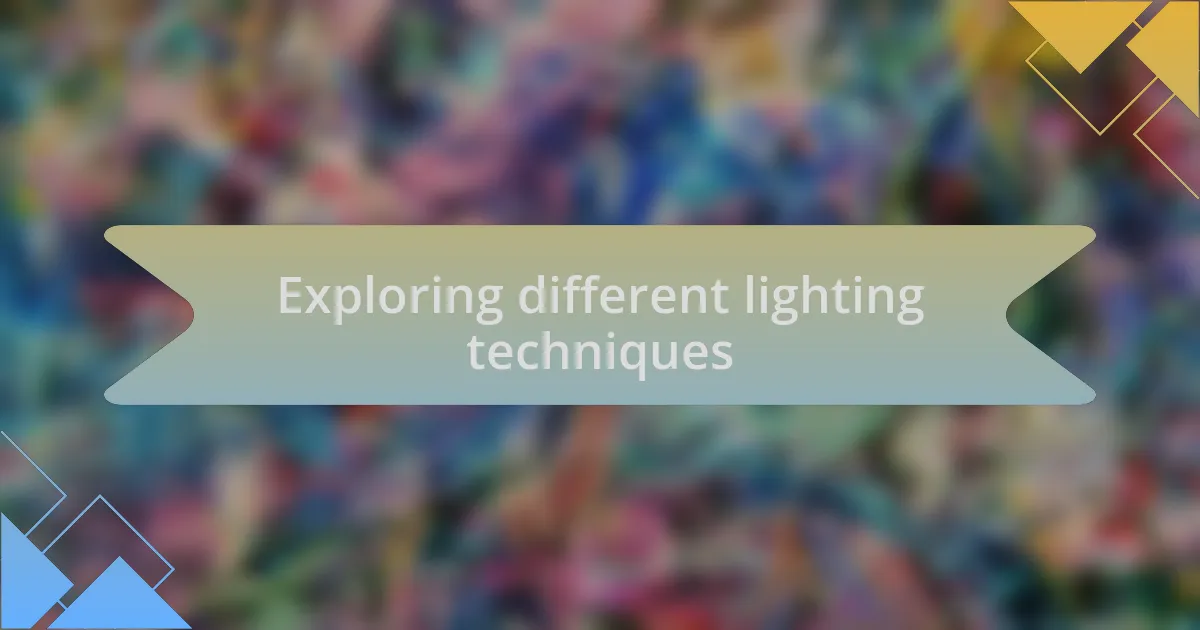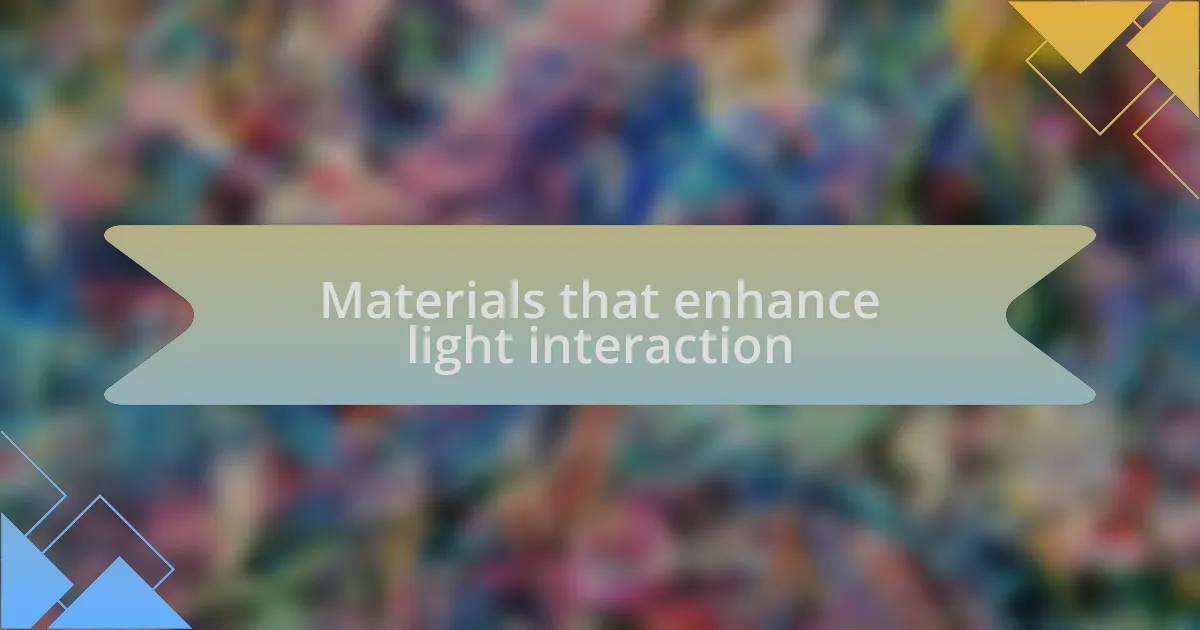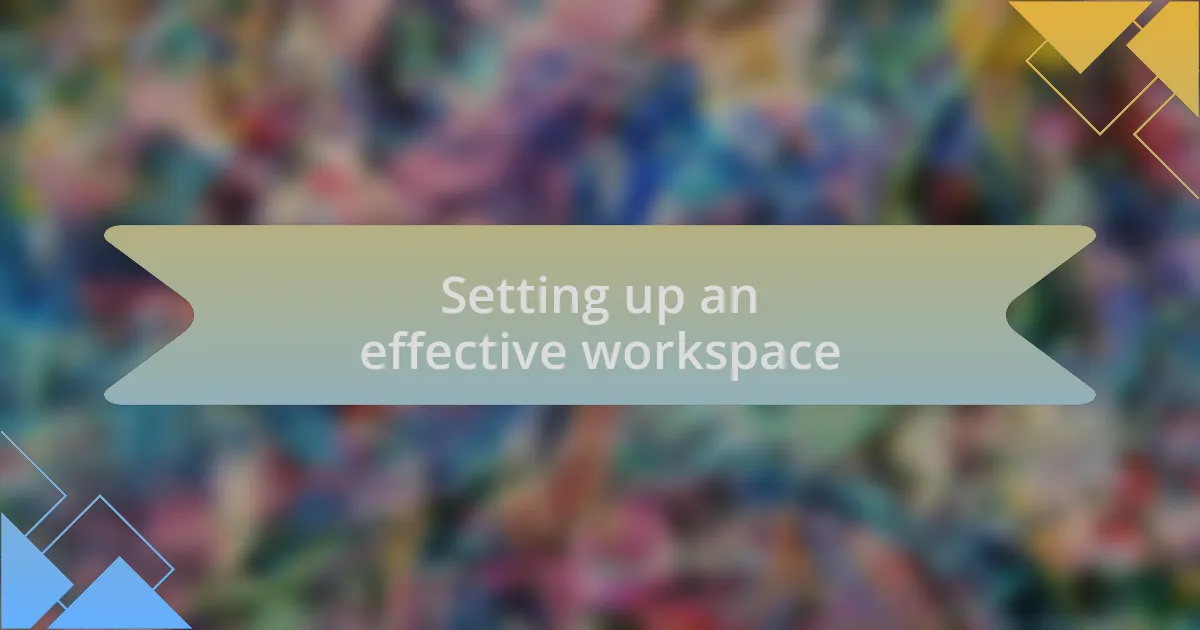Key takeaways:
- Natural light and backlighting enhance sculptures by creating dynamic, emotional experiences for viewers.
- Materials like polished metals, glass, and translucent substances are crucial for effective light interaction, adding depth to the artwork.
- Creating an organized and atmospheric workspace fosters creativity and facilitates experimentation with light effects.
- Documenting light experiments through notes and photographs helps analyze outcomes and encourages collaborative insights among artists.

Exploring different lighting techniques
When I experiment with different lighting techniques, I often find that natural light offers a unique and organic quality. For instance, placing a sculpture near a window at different times of the day reveals how shadows and highlights shift, transforming the piece almost like a living entity. Have you ever noticed how that one afternoon sunbeam can completely change the mood of a sculpture?
While artificial lighting can create dramatic effects, I’m particularly drawn to backlighting. There’s a moment of sheer magic when light streams through the translucent materials of a piece, casting unexpected patterns on surrounding surfaces. It’s fascinating to see how this technique not only illuminates but also enhances the viewer’s experience, making them stop and truly engage with the artwork in front of them.
I also enjoy experimenting with colored lighting to evoke specific emotions. A subtle blue light can create a calm atmosphere, while vibrant reds can generate excitement and passion. Reflecting on your own experiences, can you think of a time when color shifted your perception of a piece? By blending these colors, I’ve discovered that the emotional response of my audience is often amplified, revealing layers of meaning that might otherwise go unnoticed.

Materials that enhance light interaction
When it comes to materials that enhance light interaction, I’ve found that reflective surfaces such as polished metals and glass offer incredible versatility. Last year, I created a piece using stainless steel that caught not just light but the surroundings, effectively merging the environment with the sculpture itself. Isn’t it fascinating how light can transform an ordinary object into something that feels alive and dynamic?
Translucent materials like frosted acrylic or resin can be game-changers as well. I remember a project where I layered these materials, and the way they diffused light was simply enchanting. Have you ever marveled at how certain materials can soften the harshness of a direct beam, creating an ethereal glow? This quality invites the viewer to come closer and appreciate the subtle textures and patterns that emerge.
Don’t overlook the potential of natural materials like stone or wood either. I’ve worked with alabaster that, when illuminated, reveals veins of color and texture within, creating a serene yet captivating effect. Can you recall a moment when you were drawn to a sculpture just because of the way it captured the light? That’s the power of choosing the right materials; they can elevate not only the aesthetic but also the emotional resonance of the artwork.

Setting up an effective workspace
Creating an effective workspace is crucial for experimenting with light in sculpture. I remember transforming my tiny garage into a creative haven, vivid with natural light during the day and strategically placed lamps for the evenings. The interplay of shadows and brightness in that environment not only sparked my creativity but also inspired the pieces I was working on.
I’ve learned that organizing tools and materials within reach can make or break your flow. When I set up my workspace, I arranged my sculpting tools alongside different light sources, which helped me quickly test how each material responded to illumination. Isn’t it rewarding to instantly see how subtle changes in light can shift the perception of your work?
Atmosphere matters too. I have a playlist of ambient sounds I often play, creating a serene backdrop that allows me to focus. Have you ever noticed how a well-lit room can energize or calm your mind? Cultivating a space that resonates with the ambiance you desire can be the difference between a good idea and a great sculpture.

Personal experimentation with light
Experimenting with light in my sculptures has become a transformative journey. I remember one evening, as dusk settled in, I decided to use colored gels over my lamps. Watching the dramatic shifts in shadows and hues made me feel like an alchemist, transforming my work into something entirely new. Did you know that a simple filter can change the emotion a sculpture conveys? It fascinated me to see how light could evoke different feelings, just depending on its color and intensity.
In my last project, I experimented with backlighting. By placing a light source behind my sculpture, I revealed unexpected textures and shapes that were otherwise hidden. It was an exhilarating moment—what I thought was a straightforward design took on an enchanting aura when the light shone through it. Have you ever explored the idea of reverse lighting? It offers a unique perspective that can redefine the relationship between light and form.
I’ve also dabbled in using mirrors as part of my light experimentation. I strategically positioned them to reflect light onto the sculpture, creating a dialogue between the surrounding space and my work. The first time I saw the reflections dance, I was entranced. It made me question—how can I harness this reflective quality to invite viewers into a deeper experience? Each experiment teaches me more about the intimate connection between light and sculpture, and I find myself eager to dive into the next exploration.

Documenting and analyzing outcomes
Documenting the outcomes of my light experiments is an essential part of the creative process. After each session, I take detailed notes on what I observed, noting not only the technical aspects—like angles and light sources—but also how the atmosphere shifted with each adjustment. I often find myself revisiting these notes, reflecting on why certain effects worked while others didn’t. Have you noticed how capturing those fleeting moments can lead to future breakthroughs?
Alongside my notes, I find that photographs are invaluable. There’s something magical about being able to visually compare the initial setup with the final outcome. I remember capturing a shot of a sculpture illuminated by a ray of sunlight piercing through a window; the sheer contrast and play of light revealed nuances I had previously overlooked. Looking back at those images helps me analyze the emotional reactions I aim to evoke in my audience.
In the analysis phase, I often share my findings with fellow artists. This dialogue enriches my understanding and encourages diverse perspectives. I remember a lively discussion with a friend who suggested I explore warmer colors after seeing my recent work; it opened my eyes to new possibilities in emotional expression through light. Engaging with others not only sharpens my insights but also deepens the communal exploration of light in sculpture. Don’t you agree that collaboration can lead to innovative outcomes?